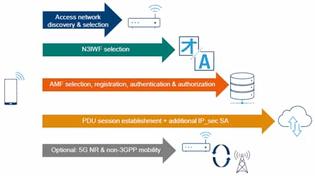
5G Internet: Architecture, Speed, and Use Cases
Explore the architecture, speed capabilities, and various use cases of 5G internet. Learn about its evolution and impact on industries.
Showing 25 posts (Page 6 of 136)
Advertisement

Explore the architecture, speed capabilities, and various use cases of 5G internet. Learn about its evolution and impact on industries.

Learn how 5G interworks with WLAN networks: benefits, limitations and real world use cases.
Explore 5G Key Performance Indicators (KPIs) categorized under eMBB, URLLC, and mMTC, and understand the 5G performance requirements set by ITU.

Explore the advantages of 5G MEC (Multi-Access Edge Computing) architecture and its benefits within 5G NR networks, including reduced latency and enhanced security.

Explore the contents and functions of 5G MIBs and SIBs as per Verizon and 3GPP standards. Learn how UEs acquire essential system information in 5G networks.

Examine 5G mission critical communication: what it offers and what drawbacks exist.
Explore the functions of key 5G network interfaces like N1, N2, N3, N4, N6, N9, and Xn. Learn how they enable seamless communication and efficient data management within the 5G architecture.

Explore the 5G network architecture and its reference points (NG1-NG15), defining the interfaces between functional blocks in a 5G NR network.

Explore 5 key advantages and disadvantages of 5G network slicing, a key technology enabling customized network performance for diverse applications and services.

Explore 5G network slicing: definition, types (vertical, horizontal, static, dynamic), functions, and its role in enabling diverse services and applications.
Explore 5G NR (New Radio) wireless technology, the global standard for 5G, offering high-speed, low-latency, and enhanced connectivity for diverse applications.
A comprehensive matrix of 5G NR 3GPP specifications, listing key documents used in developing 5G New Radio User Equipment (UE) and Base Stations.

Explore 5G NR deployment scenarios: Non-Standalone (NSA), Standalone (SA), Homogeneous, and Heterogeneous modes. Understand their characteristics and differences.
Explore the 5G NR frequency bands, focusing on FR1 (450-6000 MHz) and FR2 (24250-52600 MHz). Includes tables detailing band specifications and duplex modes like FDD and TDD.

Explore 5G NR handover types, including inter gNB and intra RAN handover (C-Plane Handling) as defined in 3GPP TS 38.300.
Learn about the different identifiers used in 5G New Radio (NR) for user equipment (UE) and network infrastructure, crucial for connection management and mobility.

Explore the functions of 5G NR network nodes, including AMF, UPF, SMF, PCF, UDM, DN, AUSF, and AF, as defined in 3GPP specifications.
Explore PRB utilization and resource allocation efficiency in 5G NR, key metrics for managing radio resources and optimizing network performance. Learn how to achieve high data rates and low latency.

Explore 5G NR-RedCap IoT: discover its features, benefits and limitations for mid-tier IoT devices.
Compare 5G NR RedCap vs LTE-M vs NB-IoT and explore difference between 5G NR-RedCap, LTE-M and NB-IoT for IoT connectivity.

Explore 5G NR security basics including key derivation algorithms and security termination points for user data and signaling.

Explore the key differences between 5G NR spectral and energy efficiency, including formulas and explanations based on the 3GPP standard.

Learn about the three RRC states in 5G NR: RRC_IDLE, RRC_INACTIVE, and RRC_CONNECTED. Understand the functions of the RRC layer and the actions performed by the UE in each state.
Understand 5G NTN and explore its benefits, challenges and use cases.

Explore the 5G Non-Terrestrial Network (NTN) protocol stack layers and their functions in both transparent and regenerative payload models.
Advertisement